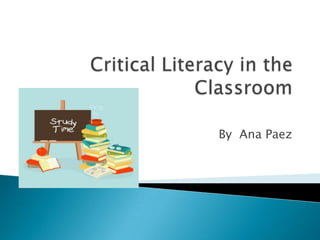
C:\Users\Anabonana\Documents\97 2003
- 1. Critical Literacy in the Classroom By Ana Paez
- 2. The importance of early literacy teaching process Expansion of background knowledge of the students. High quality books that will develop children’s reading, understanding of social issues, and in class discussions. Critical Literacy
- 3. Article #1 – “Using Read-Alouds with Critical Literacy Literature in K-3 Classrooms” Article #2 – “Books as Natural Support for Young Children's Literacy Learning” Article #3 – “Children’s Literature for Reading Strategy Instruction: Innovation or Interference?” Table of Contents
- 4. Teachers choose high quality books in order to have meaningful conversations in the classroom. When teachers choose books, they look for social issues, multicultural literacy, history books, and books that do not provide happily ever after. Teachers focus primarily on read-alouds in the classroom because they are fundamental ways of literacy teaching. Teachers use read-aloudsin means of increasing students’ comprehension skills, and teach them to become more interested in critical literacy. Educators also focus on books that will trigger meaningful discussion in the classroom. They encourage their students to think about social issues that are seen in their everyday lives. “Using Read-Alouds with Critical Literacy Literature in K-3 Classrooms”
- 5. Once teachers have selected high quality books, they outline steps that will put into action read-alouds. The steps are as follows: Select book. Preview book. Come up with critical questions. Come up with mini lessons. Do a picture walk. Stop to discuss questions from the story.
- 6. “Books play and important role in children’s social and academic development.” This quote caught my attention because I never really realized how important books were when it comes to academic development. I think it is great that teachers hold read-alouds in their classrooms, and focus on developing students’ understandings of social issues. Many children do not put much interest in reading; therefore, it is very important that teachers are becoming more aware of helping their students become more interested in high-quality literacy.
- 7. “Books as Natural Support for Young Children's Literacy Learning” Early childhood years is the most important period for literacy development. Children do not learn to read on their own. Rather they learn by “seeing and hearing others read, listening to others read to them, reading with others, and reading by themselves, and to others” (pp.7-8). When children first learn to read, they develop comprehension, writing, and listening skills. Teachers only act as a support system to their students in trying to help them become better with their comprehension skills and fluency.
- 8. Books play a big role in the development of children’s critical literacy. Teachers must have prior background knowledge when choosing books to read to their students. It will be easier for the teacher to help her/his students to understand the story, and to challenge them.
- 9. This article was very interesting because by helping students become literate thinkers, it will stimulate their reading, comprehension skills, writing, and vocabulary. I also thought it was very interesting how children do not learn to read by others, rather they learn to read by observing, and hearing others read. I was surprised how books also play a big role in the development of children’s critical literacy.
- 10. “Children’s Literature for Reading Strategy Instruction: Innovation or Interference?” When teachers use imaginative literature in the k-1classroom, they are not fully teaching their students high-quality literature. Since teachers are stimulating their student’s brains to become more literate, it is crucial that they read books that qualify as high-quality.
- 11. Even though teachers should be reading books that portray social issues real life situations; reading stories only for the sake of it can be beneficial for young students. Reading imaginative stories, stimulates children’s imagination, which can be good when learning about critical literacy.
- 12. I was very surprised by founding out that sometimes reading non high-quality books, may be important for children when trying to learn to become literate. Although, I believe that it is important that teachers stick to reading books that portray social issues because children need to learn how such issues relate to their everyday lives.
- 13. Cooper, P.. (2009). Children's Literature for Reading Strategy Instruction: Innovation or Interference? Language Arts, 86(3), 178-187. Retrieved May 4, 2010, from Research Library. (Document ID: 1635815461). http://proquest.umi.com/pqdlink?did=1635815461&Fmt=7&clientId= 13225&RQT=309&VName=PQD Gaffney, J., Ostrosky, M., & Hemmeter, M.. (2008). Books as Natural Support for Young ChildrensLiteracy Learning. YC Young Children, 63(4), 87-93. Retrieved May 4, 2010, from ProQuest Education Journals. (Document ID: 1527234151). http://proquest.umi.com/pqdlink?did=1527234151&Fmt=4&clientId=13225&RQT=309&VName Meller, W., Richardson, D., & Hatch, J.. (2009). Using Read-Alouds with Critical Literacy Literature in K-3 Classrooms. YC Young Children, 64(6), 76-78. Retrieved May 4, 2010, from ProQuest Education Journals. (Document ID: 1908826271). http://proquest.umi.com/pqdlink?did=1908826271&Fmt=4&clientId= 13225&RQT=309&VName Sources